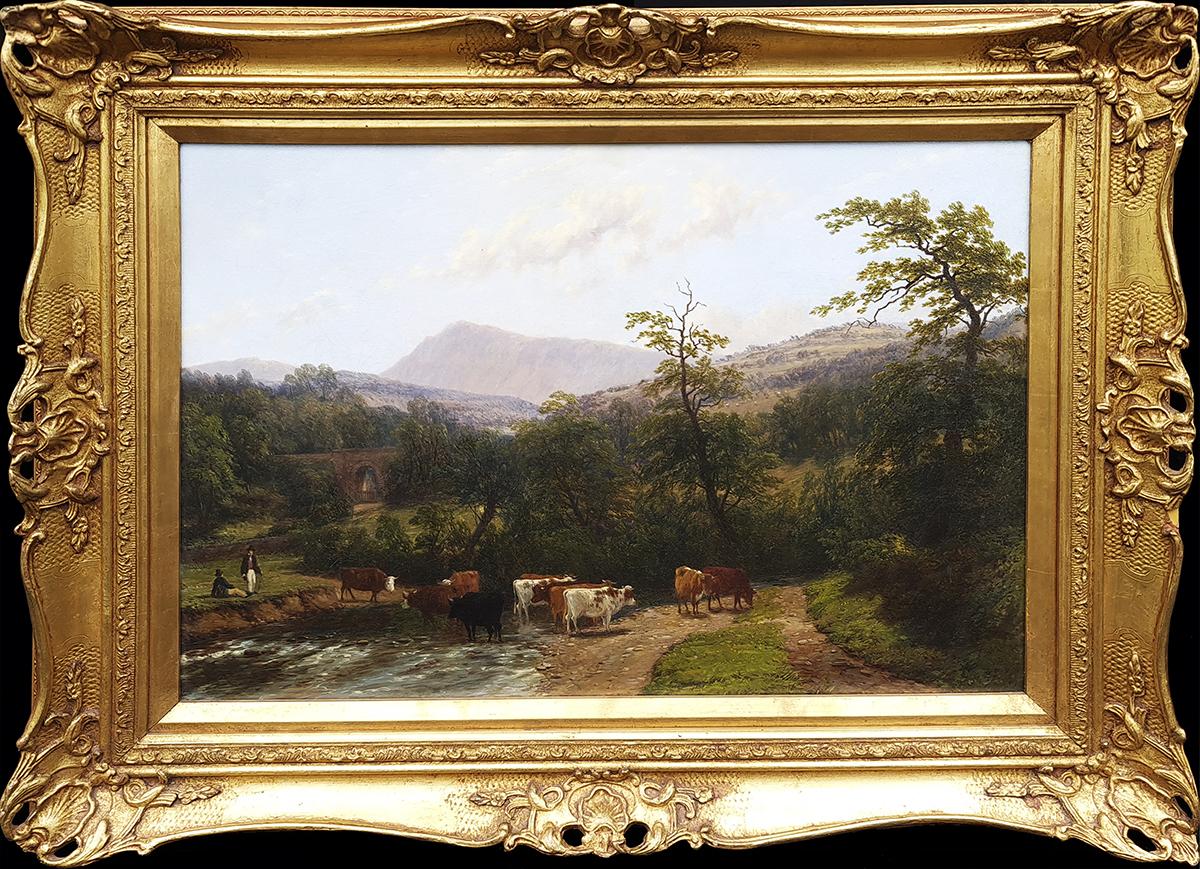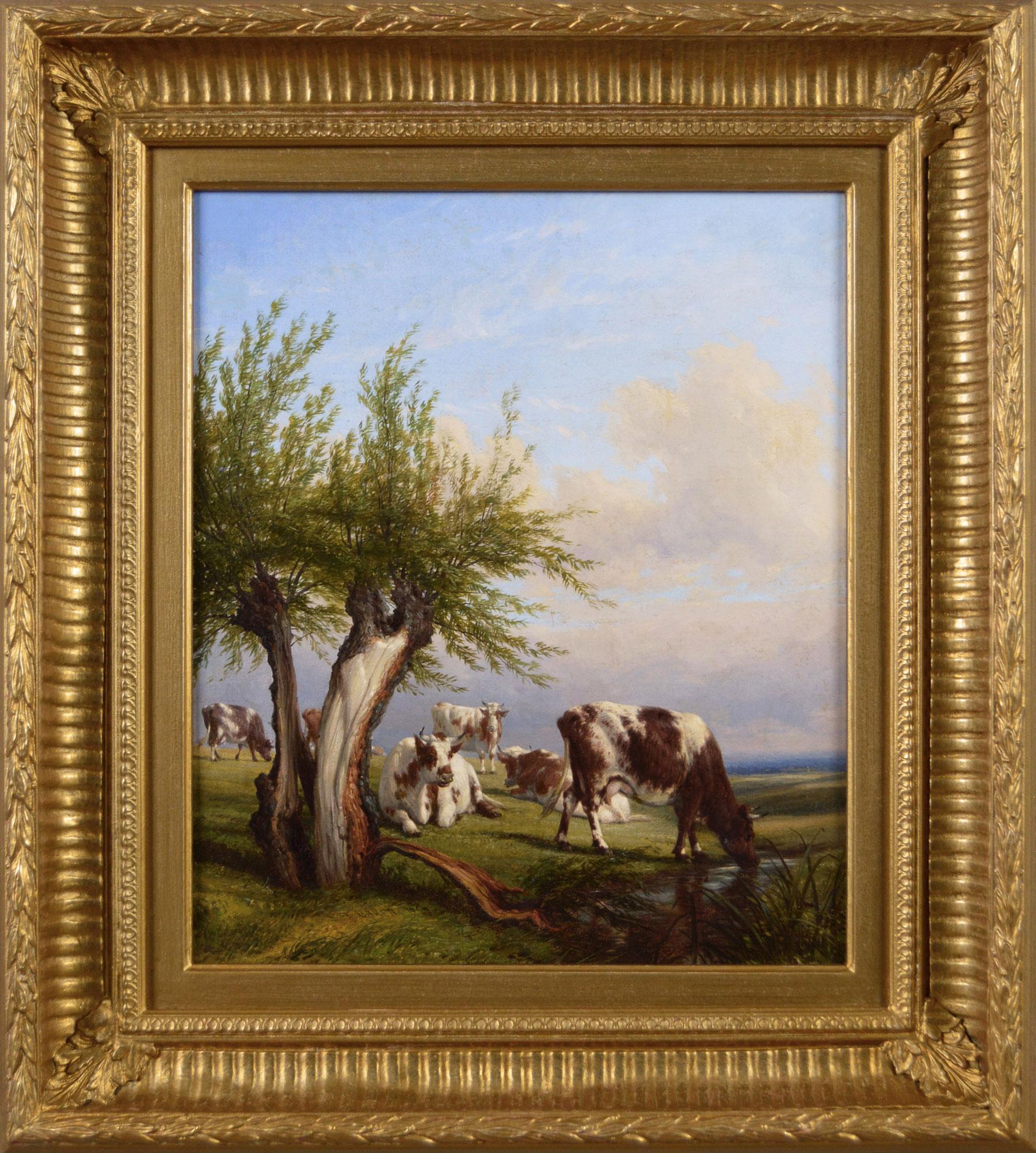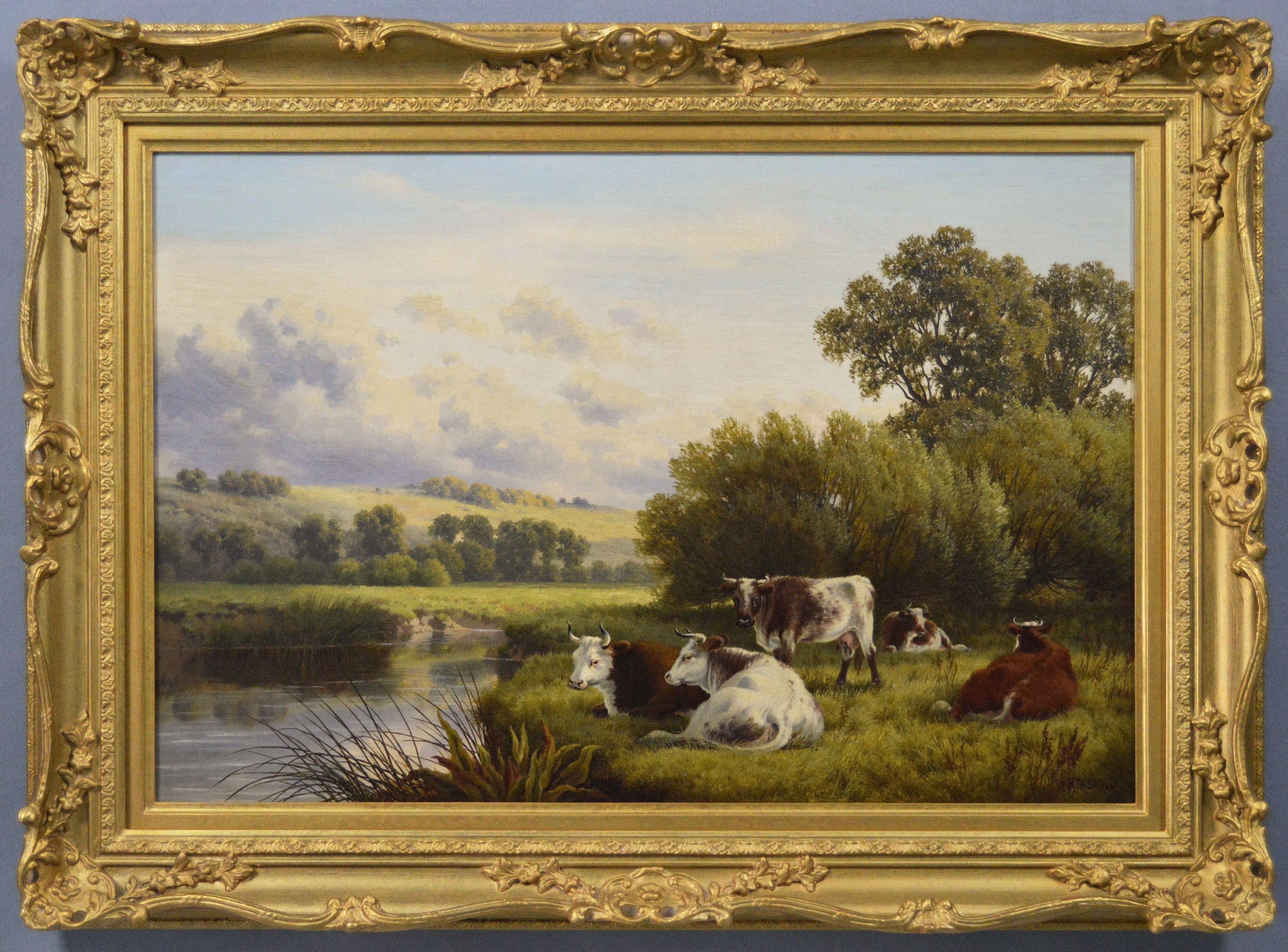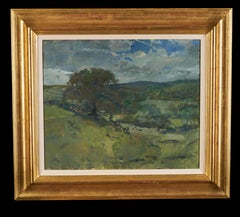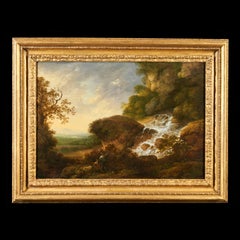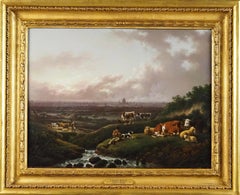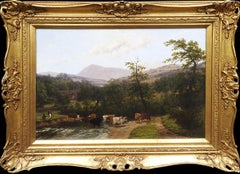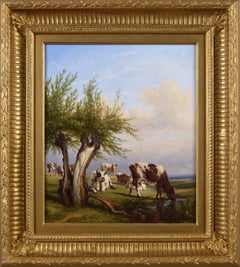Items Similar to Cattle watering in an open landscape
Want more images or videos?
Request additional images or videos from the seller
1 of 5
Joshua ShawCattle watering in an open landscape
$16,420.16
$21,892.6224% Off
£11,813
£15,75024% Off
€13,923.06
€18,563.3024% Off
CA$22,322.83
CA$29,762.5124% Off
A$25,004.44
A$33,337.8424% Off
CHF 12,999.53
CHF 17,331.9724% Off
MX$308,754.48
MX$411,655.2124% Off
NOK 165,603.75
NOK 220,795.6524% Off
SEK 156,552.58
SEK 208,727.9424% Off
DKK 103,901.51
DKK 138,529.4824% Off
Shipping
Retrieving quote...The 1stDibs Promise:
Authenticity Guarantee,
Money-Back Guarantee,
24-Hour Cancellation
About the Item
Joshua Shaw (Billingborough 1776-1860 New Jersey)
An open landscape with cattle watering
signed and dated 'J. Shaw. 1810' lower right
Oil on canvas
Canvas Size 36 x 51 in
Framed Size 40 x 55 in
Joshua Shaw was an English-American painter, inventor, and one of the pioneering figures in American landscape painting. Born in Billingborough, Lincolnshire, England, in 1776, Shaw's early life was marked by hardship. He lost his parents at a young age and was placed in the care of an uncle who apprenticed him to a sign painter. Despite these humble beginnings, Shaw's talent for art became evident.
Early Life and Career in England:
Shaw's artistic abilities blossomed under the apprenticeship, and he soon transitioned from sign painting to more sophisticated forms of art. He studied under established artists and began exhibiting his works in London. By the early 1800s, Shaw had gained some recognition, showcasing his works at the Royal Academy. However, despite his growing reputation, Shaw found the English art scene limiting.
Emigration to the United States:
In 1817, seeking greater opportunities, Shaw emigrated to the United States, where he would become a significant figure in the development of American art. He initially settled in Philadelphia, a burgeoning cultural center at the time. Shaw quickly became part of the artistic community and began to establish himself as a landscape painter.
Contributions to American Landscape Painting:
Shaw is best known for his contributions to landscape painting in America. He was instrumental in the early development of the genre, helping to establish a distinctly American style of landscape art. His works often depicted the vast, untamed wilderness of the American frontier, capturing the grandeur and sublime beauty of the natural environment. This focus on the American landscape was somewhat novel at the time and laid the groundwork for later American artists, such as the Hudson River School painters.
One of Shaw's significant projects was his collaboration with John Hill, a noted engraver, to create a series of prints titled "Picturesque Views of American Scenery." Published between 1819 and 1821, this series featured views of various American landscapes, including the natural and built environments. These prints were widely distributed and helped to popularize the American landscape genre both in the United States and abroad.
Inventions and Technical Contributions:
In addition to his work as a painter, Shaw was also an inventor. He held several patents, including one for an improved percussion cap for firearms, which was an important advancement in weaponry at the time. Shaw's inventive mind extended to his artistic practice as well; he was known for experimenting with new techniques and materials in his paintings.
Later Life and Legacy:
Throughout his career, Shaw continued to travel extensively, sketching and painting the American landscape. His works were well-received, and he exhibited frequently. In his later years, Shaw's influence as an artist and mentor continued to grow. He died in 1860, leaving behind a legacy as one of the foundational figures in American landscape painting.
Shaw's work is characterized by its attention to detail, vibrant use of color, and ability to capture the dynamic interplay between light and shadow. His paintings are held in various collections, including the Smithsonian American Art Museum and the Metropolitan Museum of Art. Joshua Shaw's contributions to American art, both as a painter and as an inventor, mark him as a key figure in the cultural history of the 19th century.
- Creator:Joshua Shaw (1776 - 1860, British)
- Dimensions:Height: 40 in (101.6 cm)Width: 55 in (139.7 cm)
- Medium:
- Movement & Style:
- Period:
- Condition:
- Gallery Location:Stoke, GB
- Reference Number:1stDibs: LU446314828122

About the Seller
5.0
Recognized Seller
These prestigious sellers are industry leaders and represent the highest echelon for item quality and design.
Platinum Seller
Premium sellers with a 4.7+ rating and 24-hour response times
Established in 2009
1stDibs seller since 2016
173 sales on 1stDibs
Typical response time: 1 hour
Associations
LAPADA - The Association of Arts & Antiques DealersInternational Confederation of Art and Antique Dealers' AssociationsThe British Antique Dealers' Association
- ShippingRetrieving quote...Shipping from: Andover, United Kingdom
- Return Policy
Authenticity Guarantee
In the unlikely event there’s an issue with an item’s authenticity, contact us within 1 year for a full refund. DetailsMoney-Back Guarantee
If your item is not as described, is damaged in transit, or does not arrive, contact us within 7 days for a full refund. Details24-Hour Cancellation
You have a 24-hour grace period in which to reconsider your purchase, with no questions asked.Vetted Professional Sellers
Our world-class sellers must adhere to strict standards for service and quality, maintaining the integrity of our listings.Price-Match Guarantee
If you find that a seller listed the same item for a lower price elsewhere, we’ll match it.Trusted Global Delivery
Our best-in-class carrier network provides specialized shipping options worldwide, including custom delivery.More From This Seller
View AllHerding cattle through a wooded river landscape
Located in Stoke, Hampshire
James Stark (1794-1859)
Herding cattle through a wooded river landscape
Oil on canvas
Canvas Size 18 x 24 in
Framed Size 23 x 29 in
James Stark (1794-1859): A Pioneer in Landscape P...
Category
18th Century Old Masters Landscape Paintings
Materials
Oil
$6,880 Sale Price
37% Off
Cattle grazing in an extensive landscape
Located in Stoke, Hampshire
Tom Coates (1941-2023)
Cattle grazing in an extensive landscape
Oil on canvas
Signed with initials lower left
Canvas Size - 20 x 24 in
Framed Size - 29 x 33 in
Tom Coates (1941–2023...
Category
20th Century Modern Landscape Paintings
Materials
Oil
Landscape with goatherds near a waterfall
Located in Stoke, Hampshire
George Smith of Chichester (1714-1776)
Landscape with goatherds near a waterfall
Oil on canvas
Signed 'Geo. Smith' lower left
Canvas Size 18 x 25 i...
Category
18th Century Landscape Paintings
Materials
Oil
London : A distant view of the city from the south with a herdsman and cattle
By Charles Towne
Located in Stoke, Hampshire
Charles Towne (1763-1840)
London : A distant view of the city from the south with a herdsman and cattle in the foreground
Oil on canvas laid on panel
Canvas Size - 14 1/2 x 19 in
Fra...
Category
Early 19th Century Victorian Landscape Paintings
Materials
Canvas, Oil
A pair of Classical landscapes
Located in Stoke, Hampshire
George Smith of Chichester (Chichester 1714-1776)
Landscape with figures resting by a river; River landscape with figures outside a thatched cottag...
Category
18th Century Old Masters Landscape Paintings
Materials
Oil
Cows grazing on a hillside
Located in Stoke, Hampshire
Fred Hall (1860-1948)
Cows grazing on a hillside
Signed 'Fred Hall' lower right
Oil on board
Painting Size - 12 x 16 in
Framed Size - 17 x 21 in
Fred Hall was a British painter who ...
Category
20th Century Impressionist Landscape Paintings
Materials
Oil
You May Also Like
Cattle Watering in a Landscape - British 19th century art Victorian oil painting
By Samuel Bough
Located in London, GB
This lovely British Victorian landscape oil painting is attributed to noted artist Sam Bough. It was painted circa 1855 after Bough had moved to Hamilton Lanarkshire in Scotland to focus on painting landscapes along side fellow artist Alexander Frazer. The composition is several cattle watering in a stream under the boughs of an ancient tree. There is superb impasto, for example on the clouds and this is a charming 19th century oil painting.
Provenance. London estate.
Condition. Oil on canvas, 29 inches by 16 inches unframed and in good condition.
Frame. Housed in an ornate gilt Victorian frame, 36 inches by 23 inches framed and in good condition.
Samuel Bough RSA (1822–1878) was an English-born landscape painter who spent much of his career working in Scotland. He was born the third of five children in Abbey Street, Carlisle in northern England, the son of James Bough (1794-1845), a shoemaker, and Lucy Walker, a cook. He was raised in relative poverty, but with a keen encouragement in the arts. He was self-taught but mixed with local artists such as Richard Harrington and George Sheffield, and was strongly influenced by the work of Turner. After an unsuccessful attempt to live as an artist in Carlisle he obtained a job and as a theatre scenery painter in Manchester in 1845, later also working in Glasgow in the same role. Encouraged by Daniel Macnee to take up landscape painting he moved to Hamilton from 1851-4 and worked there with Alexander Fraser. In 1854 he moved to Port Glasgow to work on his technique of painting ships and harbours. His paintings were noted for their sensitivity to atmosphere and light, were often of cloudy shorelines and busy harbours. He also began supplementing his income by illustrating books, before moving to Edinburgh in 1855. On coming to Edinburgh he lived in a terraced house at 5 Malta Terrace in the Stockbridge area of the city. Following Turner's example, he became a skilful painter of seaports. He was buried in Dean Cemetery Edinburgh on 23 November 1878. The grave bears a bronze medallion of his head by William Brodie...
Category
1850s Victorian Landscape Paintings
Materials
Oil
$3,780 Sale Price
20% Off
Cattle Watering
By Thomas Baker of Leamington
Located in Belgravia, London, London
Oil on canvas
Canvas size: 13 x 19 inches
Framed size: 18.25 x 24.25 inches
Signed lower left
Category
19th Century Animal Paintings
Materials
Canvas, Oil
Pastoral Landscape - British 18th century Old Master art oil painting
Located in London, GB
This superb Old Master 18th century figurative landscape oil painting is by noted French born artist Philip James Loutherbourg. who settled in England in 1771. The painting has good ...
Category
1770s Old Masters Landscape Paintings
Materials
Oil
Philip James LoutherbourgPastoral Landscape - British 18th century Old Master art oil painting, 1778
$13,460 Sale Price
20% Off
19th Century landscape oil painting of cattle
By Thomas Baker of Leamington
Located in Nr Broadway, Worcestershire
Thomas Baker
British, (1809-1864)
Cows with a Willow Tree
Oil on canvas, signed & dated 1860
Image size: 14 inches x 11.75 inches
Size including frame: 20.5 inches x 18.25 inches
P...
Category
19th Century Landscape Paintings
Materials
Canvas, Oil
19th Century landscape animal oil painting of cattle at a river
Located in Nr Broadway, Worcestershire
Henry Cheadle
British, (1852-1931)
Cattle Resting
Oil on canvas, signed & dated (18)84
Image size: 19.25 inches x 29.25 inches
Size including frame: 26.75 inches x 36.75 inches
A well-executed landscape painting of cattle at a river by Henry Cheadle. A small herd of cattle are shown resting in a meadow by the side of a river. On the other side of the bank in the distance can be seen sloping hills reminiscent of the river Avon. At the time of this painting, the artist was living at Steelhouse Lane in Birmingham.
Henry Cheadle was a landscape painter born in Birmingham on 16 May 1852 to Henry Cheadle and his wife Matilda (née Wood). His father was a hairdresser and they lived at 2a Steelhouse Lane in Birmingham. Although little can be found about his early education, he is known to have attended the Birmingham School of Art, where he won a number of prizes. He went on to study at the South Kensington Art School (later the Royal College of Art), where he also won awards including silver and bronze medals.
Cheadle began exhibiting at the Royal Birmingham Society of Artists in 1871, where he went on to become a member. He also exhibited at the Royal Society of British Artists from 1875, the Royal Cambrian Academy, Walker Art Gallery, Liverpool, Bristol Fine Art Academy as well as at Frost & Reed. He played an active part in the local art societies, becoming curator and later president of the Midlands Art Club. He also became a member of the Birmingham Art Circle where he exhibited up until his death.
By the late 1880’s, he had moved with his parents to 40 Spring Road in Edgbaston. He spent his time travelling around painting the landscapes of Gloucestershire, Worcestershire, the Midlands and North Wales. He also visited Newlyn in Cornwall where he painted a number of coastal views. He remained unmarried and lived with his parents until their deaths at the beginning of the 20th century.
He continued living in Birmingham and exhibiting until his death aged 78 on 10 January, 1931. He was buried at Key Hill Cemetery in Birmingham. Some of his paintings were gifted to the Birmingham Museum shortly after his death and hung in the Victorian Room. Two of his works can still be found at the Museum today.
Presentation: The painting is housed in a new, English made gilt frame which is in excellent condition.
Condition: As with all of our original antique oil paintings, this work is offered in ready to hang gallery condition, having just been professionally cleaned, restored and revarnished.
© Benton Fine Art
Category
19th Century Animal Paintings
Materials
Canvas, Oil
After Eugene Verboeckhoven "Passing the Brook" Oil
By Eugène Verboeckhoven
Located in Astoria, NY
After Eugene Joseph Verboeckhoven (Belgian, 1798-1881), "Passing the Brook", Oil on Canvas, 1854, unsigned. Image: 29" H x 40" W; frame: 34" H x 46" W.
Category
Mid-19th Century Realist Landscape Paintings
Materials
Canvas, Oil
$3,250 Sale Price
29% Off
More Ways To Browse
Old Antique Keys
Antique Cattle Prints
English Prints 1800s
Arthur Friedenson
Arthur Vidal Diehl
Asher Benjamin Studio
Benito Quinquela Martin
Benjamin Haughton
Bernhard Klene
Berthe Sourdillon
Betty Rhodes
Blendon Campbell
Blondelle Octavia Malone
Braldt Bralds
Brent Cotton
Brent Jensen
Brian D Horswell
Bruno Krauskopf


